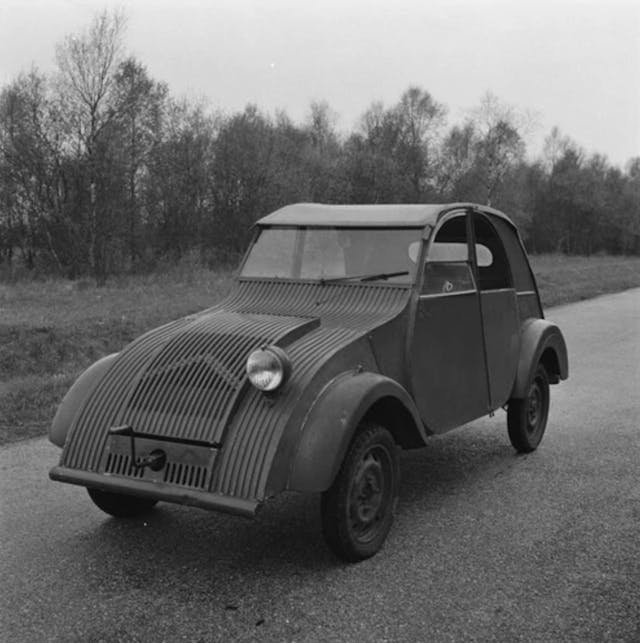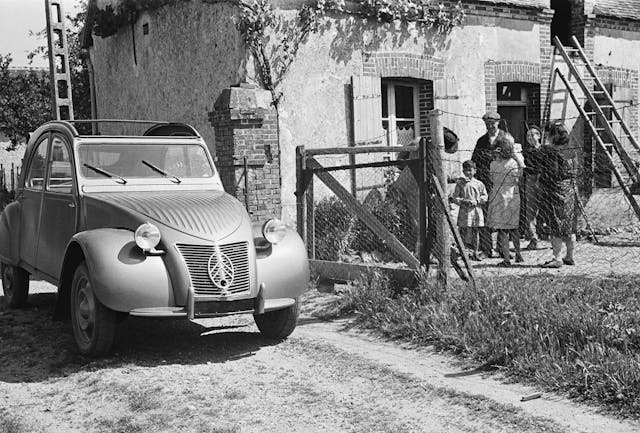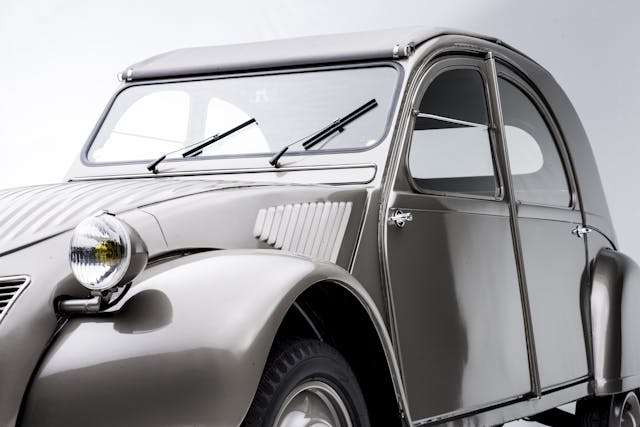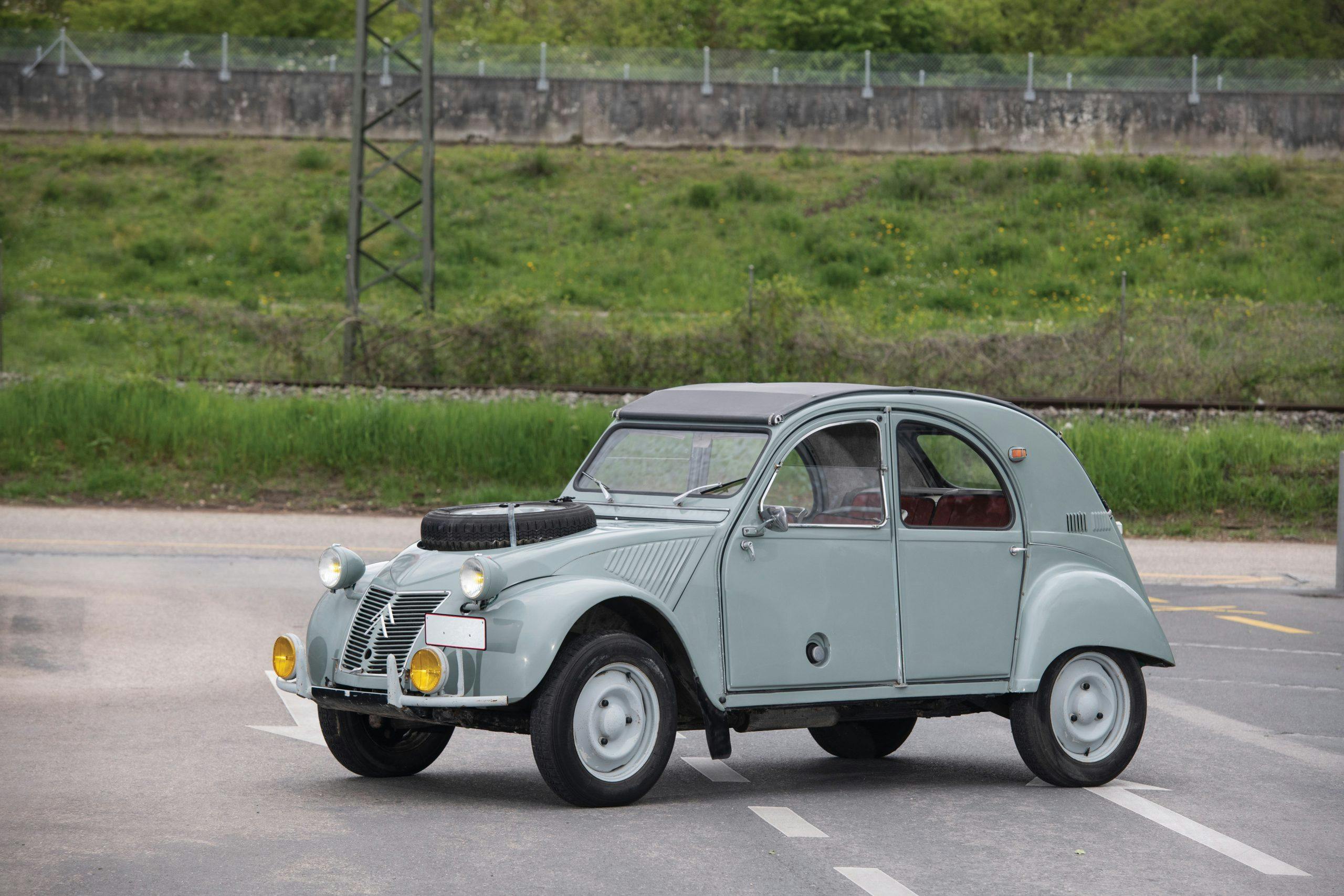Media | Articles
Your handy Citroën 2CV (1948–90) buyer’s guide
The Citroën 2CV—or Deux Chevaux—is one of those noteworthy designs that changed the automotive landscape, improving the lives of people around the world in the process. Designed to champion the needs of would-be motorists, the 2CV was engineered to be a hero for rural France, as it famously was able to transport “a basket of eggs across a ploughed field.” The compliant ride was a result of the 2CV’s ingenious suspension, along with a clever overall design that kept the car’s cost low enough for the general public to embrace a motoring lifestyle. There’s a joy in such pure simplicity, and that’s one reason why these rustic machines are still in demand today.
Model overview
Origins in the 1930s
The 2CV actually started as a TPV (Toute Petite Voiture, or Very Small Car) under the direction of Pierre Boulanger, Citroën’s Vice President. Around 47 TPV prototypes were made between 1937 and 1939, and while later iterations had incremental improvements, every example looked like a precursor to the 2CV. The TPV’s single windshield wiper, single headlight design, and a body made from flat and corrugated aluminum panels were rudimentary, but the similar shape of the cabin, canvas roof, and the slanted front end clearly previewed the 2CV to come. The two-cylinder engine was inspired by motorcycle designs of the era, but unlike the eventual 2CV, utilized water cooling instead of air cooling.

Citroën intended to build 250 units for initial production, but the ravages of World War II ensured we will never know how many TPVs were ultimately produced. During Nazi Germany’s occupation of France, Pierre Boulanger and his team dedicated themselves to protecting the design from prying eyes.
1940s, after WWII
The Citroën TPV would eventually become the 2CV, albeit with significant changes: two headlights, front-wheel drive, four-wheel independent suspension, inboard front brakes, air-cooled engine, longitudinal coil springs/dampers, and a body built with steel. The engine was a 375-cc flat two-cylinder that made only nine horsepower, thus qualifying to be called a “deux chevaux-vapeur” (two horsepower) vehicle under French tax classifications.

Much like that famous quote about the Ford Model T and black paint, the first “Type A” 2CV models were finished in gray. Front coach-style doors were retained from the TPV, and the hood had a more sophisticated rippling effect that paid homage to the TPV’s corrugated metal. The passenger cabin’s form was remarkably similar to that of the TPV, but in the 2CV the seats aped the design of tubular deckchairs. The gearshift resembled an umbrella handle, the speedometer cable actuated the wiper, and the canvas roof folded down to the rear bumper. Introduced at the 1948 Paris Auto Show, Citroën produced a few hundred 2CVs as 1948 models before full production kicked off and 876 examples were made in 1949.
Marketplace
Buy and sell classics with confidence
1950s

The Type A series 2CV continued production, while a new 2CV Fourgonnette (van) was unveiled in 1950 with great promise for French business owners. By 1951, production of the van was proving just as limited as with the popular Type A, as demand far exceeded supply. There were no substantive changes for 1952, but 1953 saw a switch to tartan interior fabric. Essential for those driving the French countryside at night, a lighted speedometer greeted drivers for 1955—the same model year that brought a new grille emblem (deleting the oval around the Citroën logo) and a new Type AZ trim level with a 425-cc, 12-hp engine.
Key upgrades in 1957 included a new starter, a turn signal light added to the instrument panel, and light gray paint (instead of black) for interior parts. A more luxurious Type AZL arrived, and could be easily spotted by its unique chrome strip down the center of the hood. The AZL also included a windscreen defogging vent (placed near the steering wheel) upgraded seat fabric, and a larger rear window.
Two new models arrived in 1958: The AZLP was notable for its metal trunklid, while the Sahara was a twin-engined, four-wheel-drive 2CV intended for travel away from paved roads. Saharas have a unique hood (with an integral tire carrier) and trunk (with open space for the auxiliary engine’s cooling fan) and are quite rare even given their nine-year production run. Changes were modest for 1959, as Citroën added a bigger windscreen defogger, along with redesigned levers on the ventilation system.
1960s

A new-for-1960 option was the removable, transistorized radio powered by a nine-volt battery, offering both in-car and outdoor entertainment as needed. A new hood with a smaller grille came in the 1961 model year, coinciding with the removal of the original 375-cc engine from the 2CV lineup.
While not technically a factory option, a larger rear decklid, folding rear seats, and relocation of the spare tire (under the hood) transformed the 1962 2CV Mixte from a French runabout into a modern-day hatchback; the kit was designed and made by ENAC but sold by Citroën. Other changes for 1962 included a more integrated dashboard/instrument panel, an extra 1.5 horsepower for a higher top speed (70 km/h to 85 km/h), and revised suspension dampers to handle the extra power.
More changes came for 1963, as a new 18-horsepower motor was fitted to the Type AZ, along with two new trim levels: the AZA and AZAM (AZ Ameliorée). (The AZL was still in production, but soldiered on with the old 12-horsepower motor.) The AZAM had chrome-plated bumpers, hubcaps, headlight rings, and hood trim. Inside the AZAM were front seats utilizing conventional seat tracks, higher-quality seat materials, new door handles and a sun visor for the front passenger. A new two-spoke steering wheel greeted all models except the AZ.
While 1964 was essentially a carryover year, 1965 brought significant changes: no more front coach-style doors, parking lights and tubeless tires were standard for all models, a revised rear seat, and different gearing for the transmission. The next year (1966) offered more new equipment, most notably 12-volt electrics with an alternator, a restyled grille (with Citroën logo on the hood) and a new body with quarter windows in the C-pillars (AZA an AZAM only). All models henceforth had hydraulic shock absorbers at the rear. Modest changes arrived for 1967: new door handles, new front door window assemblies, and revised front and rear lighting. You could even get a windshield washing system and a side-view mirror (driver’s only) in 1967. Changes at the end of the 1960s were modest overall, as the AZL received modified rear brake lights, and the cheaper AZA and AZU switched from aluminum to steel valvetrain covers.
1970s

Citroën worked hard in this beginning of this decade to squeeze more life out of the venerable 2CV, enlarging the engine from 425 to 435-cc (26 horsepower) and adding Citroën’s proven 602-cc powerplant for top performance. The larger engine’s output (33 horsepower) technically made the 2CV into a 3CV for taxation purposes, but all models retained the same name. That said, trim levels for 1970 were reduced by referring to the 435-cc examples as the “2CV 4” and giving the 602-cc examples the “2CV 6” designation. All models gained new rear lights (with turn signal indicators), standard front seat belts, and side marker lights in the front fenders.
Three-point shoulder belts were added to the front seats for 1972, while 1973 gave the 2CV 6 a very 1970s-looking single-spoke steering wheel. Rectangular headlamps—another staple of the 1970s—became standard fare for all ’74 2CVs, but 1975 brought forth a bizarre throwback: A minimalist 2CV Spécial with round headlights, an older dashboard, unique de-chromed grille, and the 2CV 4’s more affordable asking price. Burnt Orange was the theme for 1976, as the 2CV Spot arrived wearing an interior in that color, plus exterior stripes, a 2CV 6 dashboard (with 2CV4 steering wheel, powertrain, etc.), and a limited production of 1800 units. This special edition was the first of many to come.
It wasn’t until 1977 when the 2CV received locking inertia seat belts in the front, and this year had a special “basket” edition (France only) that gave the exterior the appearance of a basketball shoe, complete with hood graphics that resembled the laces of a sneaker. The last year for the smaller-engined 2CV 4 was 1978, which means the 1979 2CV Spécial got the bigger engine (and thus was a 2CV 6 Spécial). Citroën also introduced the 2CV6 Club that year.
1980s

While decidedly long in the tooth for most motoring applications, the 2CV soldiered on in the 1980s with modest improvements and a slew of special editions. The first year in this new decade brought a return to round headlamps for a retro throwback special edition to the 2CV lineup: The Charleston edition came in a two-tone burgundy scheme elegantly applied across a curvy template resembling the paint schemes commonplace in 1930s and during the 2CV’s heyday. (The 2CV Club retained its square lights.) James Bond took an interest in the 2CV in 1982, and its outsized role in For Your Eyes Only merited a run of 500 yellow commemorative editions complete with decals that duplicate the bullet holes that scarred the actual 2CV from the movie.
Front disc brakes made their way to the 2CV for 1981, while the Charleston model switched from body color headlight housings to chrome. For 1982, the Charleston switched to a more ostentatious yellow-and-black paint scheme. Its color palette was more restrained for 1983 (black and burgundy) and a white/blue stripe Beachcomber edition (dubbed “France 3” in its home market) did so well in its debut year (2000 units) that Citroën brought it back the next year. The 2CV Dolly made its debut in 1985, with six unique paint schemes. 1986 bought the rooster themed 2CV Cocorico (cock-a-doodle doo) with a blue-to-red transition paint scheme applied over a white body.
The final year for 2CV production in France was February 25, 1988; the final example was finished in red. Production continued until 1990 in Portugal, with production ending on July 27. The final example was finished in two-tone gray, but rumors of five special editions being made afterwards endure to this day. Perhaps we shall never know the truth, but such rich rumors ares a wonderful way to end such a glorious production run.
Sales in the U.S.
Nine horsepower and a fabric roof was woefully inadequate to work for large swaths of America, but Citroën sold roughly 1000 Citroën 2CVs in the States. The French company started small, selling thirteen Citroëns (not just 2CVs) in 1950. Pricing for the 2CV was $1195 (as of 1955) but the party ended in the late 1960s. There seemed to be no plans to revise the 2CV’s design for North America during that run, likely because demand in the 2CV’s home market already exceeded supply.
Differences between the U.S.-market cars and those at home were minor: American-spec examples had larger headlights to meet federal safety regulations and came with more equipment as standard equipment.
Before you buy

One of the joys of Citroën 2CV ownership is the car’s underlying simplicity, which makes the pre-purchase inspection easy. Buying an example with meticulous service records is always ideal, but most parts are readily available to address a neglected example, even in North America. Depending on where the 2CV spent most of its life, the biggest concern is likely to be rust; it can be found in the floorboards, rear fenders, door sills, doors, and frame rails. A leaky roof or window can cause rust around the roof or within the body’s A-, B-, or C-pillars. Poor repairs to collision or rust damage could be hidden if you see extensive evidence of body filler. All concerns merit a close inspection, but addressing damage in a 2CV is relatively simple, as this design needs only modest metalworking skills. That kind of work will only be necessary assuming replacement with one of many reproduction parts won’t address the issue at hand, and that’s a fairly unlikely outcome. Any sign of bumper or bumper mount damage might be quickly repaired with a new aftermarket reproduction part. Point is, you need not seek a specialist body shop to properly restore a 2CV, as the simple design allows one to perform repairs in their own garage (if so inclined).
After assessing the condition of the chassis/body, evaluate the condition of all rubber parts, wear in the kingpins/steering rack, leaks in the powertrain, and the condition of seat and rooftop fabrics. Most replacement parts are readily available, so if any concerns arise from things like the seats, window seals, hoses, or even a fuel pump diaphragm it is more of a reason to negotiate on the asking price, and not to walk away from the deal. And always consider the age of the tires: if they are 10+ years old they lose the majority of their performance and safety.

Combining the tips above with a test drive to see if the engine is healthy enough to accelerate reasonably quick up to 10-20 mph (after that you can’t expect much from a 2CV, anyway), ensure the transmission goes into its gears without crunching, and that the car can cruise at speeds above 40 MPH without issue. Make sure the test drive includes testing all features (lights, folding roof, gauges, wipers, seat belts, defogger, removable radio, etc.) to yield an accurate assessment of this 2CV’s condition and equip you with enough information to determine whether the asking price is fair relative to its condition. When in doubt, hire a professional automobile inspector to give you a full report.
Final question: Is authenticity a concern? Because Citroën 2CVs were inherently basic and simple to keep running for decades, there’s a good chance someone added a non-factory modification or two along the way. Unless you are buying a historical, museum-quality example, many 2CV upgrades improve the ownership experience and shouldn’t affect value: adding the 602-cc engine, newer carburetor, front disc brakes, extra lights, 12v alternator, electronic ignition, windshield defogger, etc. to an older Type A model will make it more livable in modern times. The value of such items are at the discretion of the buyer but are worthy of consideration.
Valuation

The Hagerty Valuation team has insight into prices for Citroën 2CVs, but please check here for the most up-to-date values. It might not come as a surprise that the four-wheel-drive Sahara models are worth roughly 275 percent more than a regular 2CV: a Sahara in #2 condition (Excellent) is worth about $93K, while a base 2CV in the same condition is worth about $23K. The gap is closing, albeit very slowly, as the last two years have witnessed a 9 percent increase in 2CV values compared to the Sahara’s 7 percent growth. The biggest change came in May 2016, when base cars increased roughly 47 percent (a full 75 percent for the debut-year 1948 2CV) and the Sahara increased 31 percent.
Quotes for 2CVs are up 35 percent over the last three years. The average Hagerty insurance quote value is up more than 14 percent over the past three years. A full 54 percent of the quotes were from baby boomers, and no quotes were requested from millennials or Gen Z.
Interested in having a 2CV to call your own? Even if most are for sale outside of North America, the best advice remains simple: Buy an example you love, but choose the best example you can afford. Happy driving, mes chéries!
Special thanks to Ronan Glon for his help in creating this buyer’s guide.








Hey there, what did a 2CV retail for in 1970 and 1990 the last year of production. In the 70’s I’m kicking myself for not buying one and touring Europe safely and at will instead of hitch hiking, training and busing around. Everyone was fighting tooth and nail for VW vans in Amsterdam, and here I could have been cruising in a 2CV. Soooooooooo, I have been looking on OOYO France car selling web site and there are a lot of 2CV’s for sale. I am thinking of getting one and re visiting Europe……So what did the 2CV retail for back in the day, 1970 and the final year 1990. With thanks, Marc, PS, I’ve cruised the web to no avail.
Ah, Marc,
those were the days! In 1974 I bought a 1954 2CV in Paris from a student for $100.00. After breaking and replacing both front stub axels and getting a trunk lid off a wreck in front of the Soborne administration building, I drove to England. While there, I did a valve job in someone’s garden potting shed to get the second cylinder firing. Now with everything running it was all around the British Isles, back to France, up to Norway, down to Venice and then to Germany for the flight home. Wish I still had it, remembering blasting down a steep grade on the autobahn one night in a pouring rain until the speedometer driven wiper blades self destructed.
You’ve said “Sahara models are worth roughly 275 percent more than a regular 2CV: a Sahara in #2 condition (Excellent) is worth about $93K, while a base 2CV in the same condition is worth about $23K”.
I hope your maths is better when you calculate your customers’ premiums.
$93K is just over 304% more than $23K.